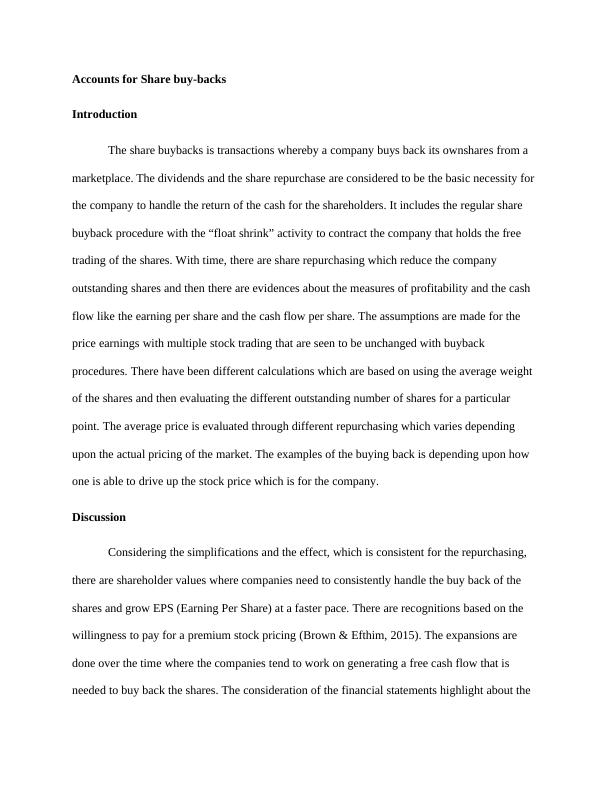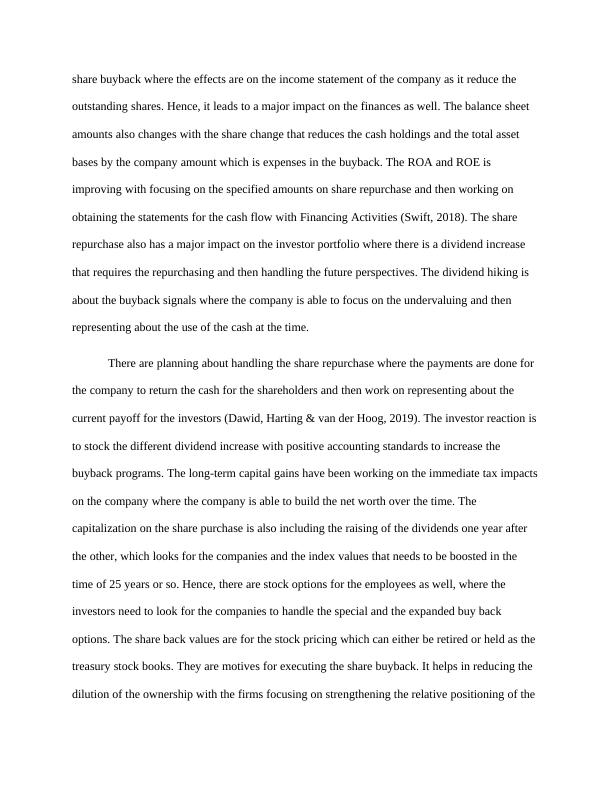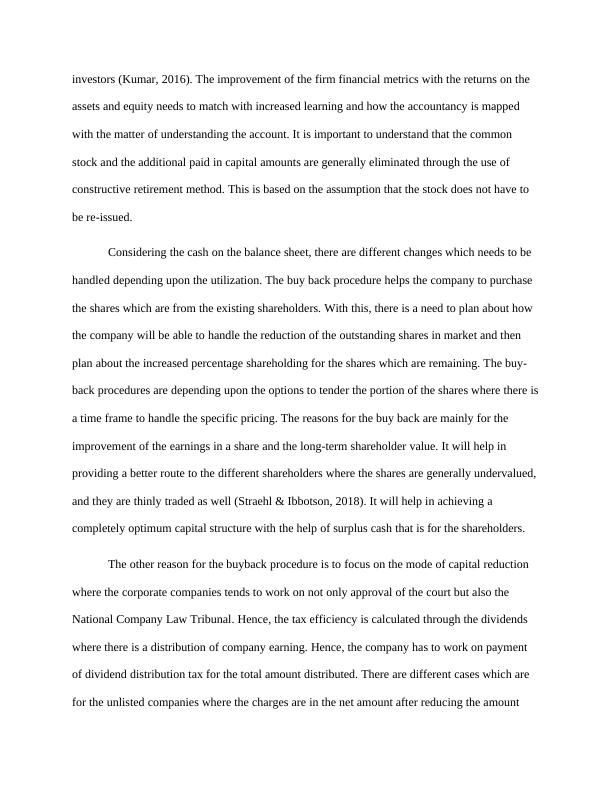Accounts for Share buy-backs
Added on 2022-11-13
6 Pages1932 Words214 Views
Accounts for Share buy-backs
Introduction
The share buybacks is transactions whereby a company buys back its ownshares from a
marketplace. The dividends and the share repurchase are considered to be the basic necessity for
the company to handle the return of the cash for the shareholders. It includes the regular share
buyback procedure with the “float shrink” activity to contract the company that holds the free
trading of the shares. With time, there are share repurchasing which reduce the company
outstanding shares and then there are evidences about the measures of profitability and the cash
flow like the earning per share and the cash flow per share. The assumptions are made for the
price earnings with multiple stock trading that are seen to be unchanged with buyback
procedures. There have been different calculations which are based on using the average weight
of the shares and then evaluating the different outstanding number of shares for a particular
point. The average price is evaluated through different repurchasing which varies depending
upon the actual pricing of the market. The examples of the buying back is depending upon how
one is able to drive up the stock price which is for the company.
Discussion
Considering the simplifications and the effect, which is consistent for the repurchasing,
there are shareholder values where companies need to consistently handle the buy back of the
shares and grow EPS (Earning Per Share) at a faster pace. There are recognitions based on the
willingness to pay for a premium stock pricing (Brown & Efthim, 2015). The expansions are
done over the time where the companies tend to work on generating a free cash flow that is
needed to buy back the shares. The consideration of the financial statements highlight about the
Introduction
The share buybacks is transactions whereby a company buys back its ownshares from a
marketplace. The dividends and the share repurchase are considered to be the basic necessity for
the company to handle the return of the cash for the shareholders. It includes the regular share
buyback procedure with the “float shrink” activity to contract the company that holds the free
trading of the shares. With time, there are share repurchasing which reduce the company
outstanding shares and then there are evidences about the measures of profitability and the cash
flow like the earning per share and the cash flow per share. The assumptions are made for the
price earnings with multiple stock trading that are seen to be unchanged with buyback
procedures. There have been different calculations which are based on using the average weight
of the shares and then evaluating the different outstanding number of shares for a particular
point. The average price is evaluated through different repurchasing which varies depending
upon the actual pricing of the market. The examples of the buying back is depending upon how
one is able to drive up the stock price which is for the company.
Discussion
Considering the simplifications and the effect, which is consistent for the repurchasing,
there are shareholder values where companies need to consistently handle the buy back of the
shares and grow EPS (Earning Per Share) at a faster pace. There are recognitions based on the
willingness to pay for a premium stock pricing (Brown & Efthim, 2015). The expansions are
done over the time where the companies tend to work on generating a free cash flow that is
needed to buy back the shares. The consideration of the financial statements highlight about the

share buyback where the effects are on the income statement of the company as it reduce the
outstanding shares. Hence, it leads to a major impact on the finances as well. The balance sheet
amounts also changes with the share change that reduces the cash holdings and the total asset
bases by the company amount which is expenses in the buyback. The ROA and ROE is
improving with focusing on the specified amounts on share repurchase and then working on
obtaining the statements for the cash flow with Financing Activities (Swift, 2018). The share
repurchase also has a major impact on the investor portfolio where there is a dividend increase
that requires the repurchasing and then handling the future perspectives. The dividend hiking is
about the buyback signals where the company is able to focus on the undervaluing and then
representing about the use of the cash at the time.
There are planning about handling the share repurchase where the payments are done for
the company to return the cash for the shareholders and then work on representing about the
current payoff for the investors (Dawid, Harting & van der Hoog, 2019). The investor reaction is
to stock the different dividend increase with positive accounting standards to increase the
buyback programs. The long-term capital gains have been working on the immediate tax impacts
on the company where the company is able to build the net worth over the time. The
capitalization on the share purchase is also including the raising of the dividends one year after
the other, which looks for the companies and the index values that needs to be boosted in the
time of 25 years or so. Hence, there are stock options for the employees as well, where the
investors need to look for the companies to handle the special and the expanded buy back
options. The share back values are for the stock pricing which can either be retired or held as the
treasury stock books. They are motives for executing the share buyback. It helps in reducing the
dilution of the ownership with the firms focusing on strengthening the relative positioning of the
outstanding shares. Hence, it leads to a major impact on the finances as well. The balance sheet
amounts also changes with the share change that reduces the cash holdings and the total asset
bases by the company amount which is expenses in the buyback. The ROA and ROE is
improving with focusing on the specified amounts on share repurchase and then working on
obtaining the statements for the cash flow with Financing Activities (Swift, 2018). The share
repurchase also has a major impact on the investor portfolio where there is a dividend increase
that requires the repurchasing and then handling the future perspectives. The dividend hiking is
about the buyback signals where the company is able to focus on the undervaluing and then
representing about the use of the cash at the time.
There are planning about handling the share repurchase where the payments are done for
the company to return the cash for the shareholders and then work on representing about the
current payoff for the investors (Dawid, Harting & van der Hoog, 2019). The investor reaction is
to stock the different dividend increase with positive accounting standards to increase the
buyback programs. The long-term capital gains have been working on the immediate tax impacts
on the company where the company is able to build the net worth over the time. The
capitalization on the share purchase is also including the raising of the dividends one year after
the other, which looks for the companies and the index values that needs to be boosted in the
time of 25 years or so. Hence, there are stock options for the employees as well, where the
investors need to look for the companies to handle the special and the expanded buy back
options. The share back values are for the stock pricing which can either be retired or held as the
treasury stock books. They are motives for executing the share buyback. It helps in reducing the
dilution of the ownership with the firms focusing on strengthening the relative positioning of the

investors (Kumar, 2016). The improvement of the firm financial metrics with the returns on the
assets and equity needs to match with increased learning and how the accountancy is mapped
with the matter of understanding the account. It is important to understand that the common
stock and the additional paid in capital amounts are generally eliminated through the use of
constructive retirement method. This is based on the assumption that the stock does not have to
be re-issued.
Considering the cash on the balance sheet, there are different changes which needs to be
handled depending upon the utilization. The buy back procedure helps the company to purchase
the shares which are from the existing shareholders. With this, there is a need to plan about how
the company will be able to handle the reduction of the outstanding shares in market and then
plan about the increased percentage shareholding for the shares which are remaining. The buy-
back procedures are depending upon the options to tender the portion of the shares where there is
a time frame to handle the specific pricing. The reasons for the buy back are mainly for the
improvement of the earnings in a share and the long-term shareholder value. It will help in
providing a better route to the different shareholders where the shares are generally undervalued,
and they are thinly traded as well (Straehl & Ibbotson, 2018). It will help in achieving a
completely optimum capital structure with the help of surplus cash that is for the shareholders.
The other reason for the buyback procedure is to focus on the mode of capital reduction
where the corporate companies tends to work on not only approval of the court but also the
National Company Law Tribunal. Hence, the tax efficiency is calculated through the dividends
where there is a distribution of company earning. Hence, the company has to work on payment
of dividend distribution tax for the total amount distributed. There are different cases which are
for the unlisted companies where the charges are in the net amount after reducing the amount
assets and equity needs to match with increased learning and how the accountancy is mapped
with the matter of understanding the account. It is important to understand that the common
stock and the additional paid in capital amounts are generally eliminated through the use of
constructive retirement method. This is based on the assumption that the stock does not have to
be re-issued.
Considering the cash on the balance sheet, there are different changes which needs to be
handled depending upon the utilization. The buy back procedure helps the company to purchase
the shares which are from the existing shareholders. With this, there is a need to plan about how
the company will be able to handle the reduction of the outstanding shares in market and then
plan about the increased percentage shareholding for the shares which are remaining. The buy-
back procedures are depending upon the options to tender the portion of the shares where there is
a time frame to handle the specific pricing. The reasons for the buy back are mainly for the
improvement of the earnings in a share and the long-term shareholder value. It will help in
providing a better route to the different shareholders where the shares are generally undervalued,
and they are thinly traded as well (Straehl & Ibbotson, 2018). It will help in achieving a
completely optimum capital structure with the help of surplus cash that is for the shareholders.
The other reason for the buyback procedure is to focus on the mode of capital reduction
where the corporate companies tends to work on not only approval of the court but also the
National Company Law Tribunal. Hence, the tax efficiency is calculated through the dividends
where there is a distribution of company earning. Hence, the company has to work on payment
of dividend distribution tax for the total amount distributed. There are different cases which are
for the unlisted companies where the charges are in the net amount after reducing the amount

End of preview
Want to access all the pages? Upload your documents or become a member.
Related Documents
Accounts for Share Buy-Backslg...
|7
|1340
|73
Real Estate Equities: Buy Back and Capital Raising Scenarioslg...
|14
|3662
|88
Alternatives for Business Expansionlg...
|5
|1286
|81
Effect of Dividend Methods on Wealth and EPS in Financelg...
|4
|530
|464
Accounting and Financial Managementlg...
|5
|609
|126
Dividends and Share Repurchases: Assignmentlg...
|20
|1829
|62
